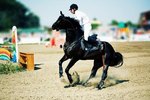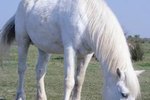
Your horse was designed by nature to spend the majority of his days roaming freely across grasslands, consuming forage for an average of 16 hours a day. If you're keeping your horse in a stall, he likely is not getting nearly as much physical activity or exercise as he would in a more natural setting. If your horse is spending most of his time in a stall, he may show signs of boredom.
Cribbing
Cribbing is a behavior that horses may develop when they're kept in a stall or small paddock for the majority of their time. Horses who crib can be seen gripping wood fences, fence posts, gates or other solid objects with their teeth and then sucking wind through their mouths. The process releases endorphines in the horse's brain, making him feel good. It's common for a bored horse to start cribbing as a way to entertain himself. The process can be destructive because horses who crib tend to bite and chew up wooden boards as well. They may also suffer from a decreased appetite or lose weight because of how much time they spend cribbing.
Weaving or Pacing
Horses that weave can be seen bobbing back and forth in their stalls; most often this behavior occurs in front of the gate or door. The horse will shift his weight back and forth in front of the door opening for hours on end. Pacing occurs when a horse walks back and forth across the front of a stall or constantly walks in circles within the confines of his stall. Both of these behaviors are signs that your horse is bored and lonely inside his stall.
Other Vices
Generally speaking, any truly undesirable behaviors that your horse develops as a result of spending a significant amount of time bored in his stall are called stable vices. In addition the behaviors listed above, horses who display vices may kick the sides of their stalls constantly, especially during feeding times. They may also experience severe separation anxiety, calling out frequently when other horses walk past the stall or are removed from the barn. Some horses will become headtossers, throwing their heads up and down frequently for no reason, while others may become aggressive. Horses who become aggressive as a result of boredom may injure other horses or people by biting or kicking.
Curing Boredom in the Stall
The best cure for your horse's stall boredom is being turned outside into a pasture with other horses. If that's not an option, try to make sure he can at least go out in a paddock for a few hours every day. You should also make sure to ride regularly and get him plenty of exercise as well as provide plenty of hay for him to eat while he's in his stall. In some cases, a toy ball that's designed for horses to play with can also help entertain a bored horse.
References
Photo Credits
-
Jupiterimages/Photos.com/Getty Images
Writer Bio
Jen Davis has been writing since 2004. She has served as a newspaper reporter and her freelance articles have appeared in magazines such as "Horses Incorporated," "The Paisley Pony" and "Alabama Living." Davis earned her Bachelor of Arts in communication with a concentration in journalism from Berry College in Rome, Ga.




